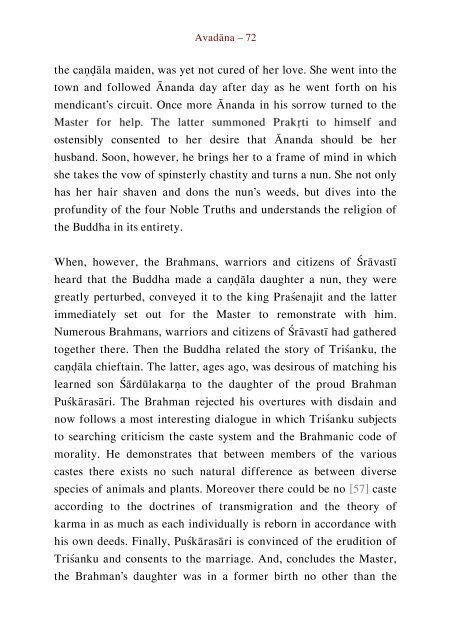Literary History of Sanskrit Buddhism
A study by J. K. Nariman of Sanskrit Buddhism from the Early Buddhist Tradition up to the Mahayana texts proper.
A study by J. K. Nariman of Sanskrit Buddhism from the Early Buddhist Tradition up to the Mahayana texts proper.
Create successful ePaper yourself
Turn your PDF publications into a flip-book with our unique Google optimized e-Paper software.
Avadāna – 72<br />
the caṇḍāla maiden, was yet not cured <strong>of</strong> her love. She went into the<br />
town and followed Ānanda day after day as he went forth on his<br />
mendicant’s circuit. Once more Ānanda in his sorrow turned to the<br />
ostensibly consented to her desire that Ānanda should be her<br />
husband. Soon, however, he brings her to a frame <strong>of</strong> mind in which<br />
she takes the vow <strong>of</strong> spinsterly chastity and turns a nun. She not only<br />
has her hair shaven and dons the nun’s weeds, but dives into the<br />
pr<strong>of</strong>undity <strong>of</strong> the four Noble Truths and understands the religion <strong>of</strong><br />
the Buddha in its entirety.<br />
When, however, the Brahmans, warriors and citizens <strong>of</strong> Śrāvastī<br />
heard that the Buddha made a caṇḍāla daughter a nun, they were<br />
greatly perturbed, conveyed it to the king Praśenajit and the latter<br />
immediately set out for the Master to remonstrate with him.<br />
Numerous Brahmans, warriors and citizens <strong>of</strong> Śrāvastī had gathered<br />
together there. Then the Buddha related the story <strong>of</strong> Triśanku, the<br />
caṇḍāla chieftain. The latter, ages ago, was desirous <strong>of</strong> matching his<br />
learned son Śārdūlakarṇa to the daughter <strong>of</strong> the proud Brahman<br />
Puśkārasāri. The Brahman rejected his overtures with disdain and<br />
now follows a most interesting dialogue in which Triśanku subjects<br />
to searching criticism the caste system and the Brahmanic code <strong>of</strong><br />
morality. He demonstrates that between members <strong>of</strong> the various<br />
castes there exists no such natural difference as between diverse<br />
species <strong>of</strong> animals and plants. Moreover there could be no [57] caste<br />
according to the doctrines <strong>of</strong> transmigration and the theory <strong>of</strong><br />
karma in as much as each individually is reborn in accordance with<br />
his own deeds. Finally, Puśkārasāri is convinced <strong>of</strong> the erudition <strong>of</strong><br />
Triśanku and consents to the marriage. And, concludes the Master,<br />
the Brahman’s daughter was in a former birth no other than the


















